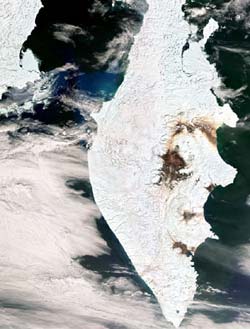Erupting volcano casts shadow on Russian peninsula

This reduced resolution Medium Resolution Imaging Spectrometer (MERIS) image was acquired 11 May 2004 and shows the Kamchatka Peninsula in Russia’s Far East. The erupting Shiveluch volcano is located towards the right of the peninsula about two thirds of the way up - around it is a circular band of dark ash from the eruption visible over snow. <br> <br>Credits: ESA 2004
The most northerly active volcano on Russia’s Kamchatka Peninsula is once again erupting, dusting the surrounding snow-white landscape with a wide expanse of dark ash that is visible from 800 km away in space.
This image of the Kamchatka Peninsula on Russia’s East Coast was acquired on 11 May 2004 by the Medium Resolution Imaging Spectrometer (MERIS) instrument on ESA’s Envisat satellite in reduced resolution mode.
Two thirds of the way up the Peninsula can be seen a roughly circular band of ash, and at the high point of this band is located the steep-sided 3283-metre-high Shiveluch stratovolcano. An aerial cloud of steam and possibly ash originating from the peak is also faintly visible against the ocean to the east of the Peninsula.
Part of the volcanic ’Ring of Fire’ chain located around the Pacific, Shiveluch – also known as Sheveluch – last erupted in 2001. After a two-year lull volcanic activity began again at the start of this year, and on 9 May the volcano underwent an explosive eruption, propelling ash and volcanic gases into the atmosphere up to eight km above sea level.
The locally-based Kamchatkan Volcanic Eruptions Response Team has observed a lava dome growing in the crater and warn that another explosive eruption could be due at any time. Strong volcanic tremors and surface earthquakes have been detected, while heavy mudslides from Shiveluch have also blocked roads in the area.
Media Contact
More Information:
http://www.esa.int/esaSA/SEMQOSGHZTD_earth_0.htmlAll latest news from the category: Earth Sciences
Earth Sciences (also referred to as Geosciences), which deals with basic issues surrounding our planet, plays a vital role in the area of energy and raw materials supply.
Earth Sciences comprises subjects such as geology, geography, geological informatics, paleontology, mineralogy, petrography, crystallography, geophysics, geodesy, glaciology, cartography, photogrammetry, meteorology and seismology, early-warning systems, earthquake research and polar research.
Newest articles

Superradiant atoms could push the boundaries of how precisely time can be measured
Superradiant atoms can help us measure time more precisely than ever. In a new study, researchers from the University of Copenhagen present a new method for measuring the time interval,…

Ion thermoelectric conversion devices for near room temperature
The electrode sheet of the thermoelectric device consists of ionic hydrogel, which is sandwiched between the electrodes to form, and the Prussian blue on the electrode undergoes a redox reaction…

Zap Energy achieves 37-million-degree temperatures in a compact device
New publication reports record electron temperatures for a small-scale, sheared-flow-stabilized Z-pinch fusion device. In the nine decades since humans first produced fusion reactions, only a few fusion technologies have demonstrated…





















